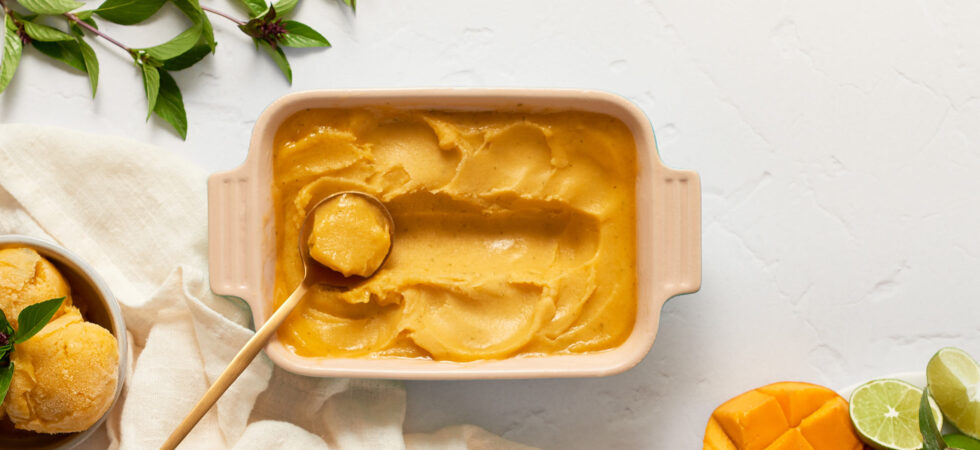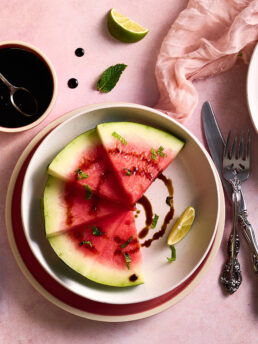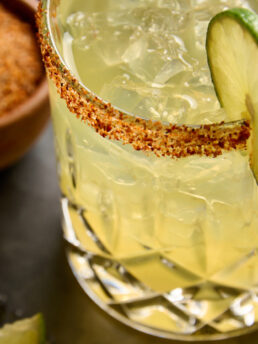Mango Pineapple Sorbet

This mango pineaple sorbet is brimming with all of the tropical flavors: mango; pineapple; ginger; lime; and Thai basil. It’s refreshing yet rich. The perfect combination to satisfy those end of summer cravings. Enjoy friends!

Get the Recipe: Mango Pineapple Sorbet
Ingredients
- 1 cup water
- 1 cup granulated sugar
- ¼ cup + 2tbsp fresh Thai basil leaves, divided as written
- 2 cups pineapple, (roughly 1/2 a pineapple) trimmed and chopped
- 2 cups Ataulfo (honey) mangos, (roughly 3-4 mangos) peeled, pitted, and chopped
- 4 teaspoons fresh grated ginger
- 2 tablespoons lime zest , (roughly 2 limes)
- ¼ teaspoon kosher salt
- 1.5 oz fresh lime juice
- 1.5 oz Cointreau
Equipment
- 1 Small Sauce Pot
- 1 spatula
- 1 cutting board
- 1 chef knife
- 1 paring knife
- 1 spoon
- 1 microplane or fine zester
- measuring Cups
- Measuring spoons
- kitchen scale optional
- 1 blender
- 1 Fine Mesh Strainer
- 1 ice cream maker optional
- 1 container
Instructions
- First make the Thai basil simple syrup. Combine the sugar and water in a small saucepan on the stovetop and bring them to a boil. When the syrup reaches between 215-220°F (101.5-104.5°C) turn off the burner and add in the basil. Set aside and let the syrup cool to room temperature.
- Next prepare the other ingredients for the blender. For the pineapple, cut off the top and bottom to create a flat cutting surface. Then, use a chef knife to cut down the standing pineapple and split it in two. Take one half of the pineapple and split it into quarter and then eighth wedges. For each wedge, slide the knife between the flesh and the outer skin and then separate the flesh from the inner core to form a usable plank of fruit. Roughly chop the pieces and add them to the blender until the correct amount has been chopped.
- For the mango, use a paring knife to cut from top to bottom as closely to the pit as possible on the widest sides. Then, use a spoon to scoop the flesh of the fruit from the peel. There may be some smaller strips of fruit you can take off from the narrow sides and bottom as well. Rough chop these pieces and add them to the blender.
- Next, zest the limes with a Microplane or zester. Slice them in half and squeeze the lime juice. Then, use the edge of a spoon to scrape the skin off of your fresh ginger. Grate the ginger until you have enough for the sorbet. Measure out the salt, Cointreau, and Thai basil leaves. Add everything to the blender.
- By now, the Thai basil syrup should be cooled. Strain the simple syrup and pour that into the blender. Turn your blender to high for 1-2 minutes to make sure everything is well broken down.
- Pour the blended ingredients into a medium sized bowl and refrigerate until very chilled. At least 1 hour. After chilling, pour the final mixture into an ice cream maker. Freeze to the manufacturer's instructions and when done, scrape out of the mixer and into a freezer safe container. (see notes: if you don't have an ice cream maker)
- Freeze for at least another 4 hours or overnight for best results.
Notes
- DON’T FORGET to pre-freeze your ice cream machine’s bowl if you have a bowl style ice cream maker.
- To cool the simple syrup faster, place it in the refrigerator or you can nest your saucepan in a bowl of ice and stir until the syrup is chilled.
- Don’t have Cointreau? Feel free to use tequila or rum instead.
- The sorbet’s texture is its creamiest/freshest within 2 weeks of making it. However, it can last as long as 1 month in the freezer before developing freezer burn and/or a stale mouthfeel.
- This recipe fills up a 9x5x2.5 (22.86×12.7×6.35cm) loaf pan about ¾ of the way. So, if you want to use a different vessel or insulated ice cream container, just make sure it can hold up to 8c or 1.9L of ice cream
Nutrition

Frequently Asked Questions
There are typically 2 kinds of mangos sold in U.S. grocery stores, Ataulfo mangos and Tommy Atkins mangos. You can tell them apart a few different ways:
1. Size/shape: The Ataulfo mango is smaller in size than the Tommy Atkins. Tommy Atkins mangos are also far rounder and taper almost uniformly on the top and bottom of the mango. Ataulfo mangos are narrower with a rounder bottom and more tapered top. The tops also have a bit of a curve to them, though not a fully hooked shape.
2. Color: Ataulfo mango is green when under ripe and turn fully yellow at peak ripeness. Tommy Atkins mangoes have varying hues of red, yellow, and green. As the Tommy Atkins mango ripens, the darker green color turns to a yellow-green, while the yellow and red both darken in color.
3. Texture: Though both mangoes can have similar levels of sweetness, when fully ripe and at the peak of their season, Tommy Atkins mangoes are far more fibrous than Ataulfo mangoes. Essentially, I picked the Ataulfo mangoes for my pineapple, mango tropical sorbet to avoid the added step of straining the blended fruit purée. They are the superior mangoes to use for smoother applications, like smoothies and sorbets.
Can’t find Ataulfo (honey) mangos?
You can use one of its multicolored (green, yellow, and red) cousins the Tommy Atkins or the Keitt (if you can find it). However, these tend to be more fibrous. If you use these, cut up more mango pieces than you need by about 20% (so ≈ 1/2 cup or 65g more than the recipe calls for). Then, blend and strain the mango separately all before adding it to the rest of the ingredients. Believe me, a mouth full of mango fibers is not fun.
Of Note: Blending fibrous mangoes might give your blender a bit of trouble. If you need it, use the simple syrup to help loosen the mixture and make blending easier. Most of the syrup will strain out, as it’s a liquid. And, since this recipe is fairly forgiving, a little less simple syrup isn’t going to hurt anything.
If you don’t have access to Thai basil, you can get relatively close results, by making a slightly anise flavored simple syrup. Use the same syrup instructions, but steep 2, star anise pods once you’ve cut the heat. Then add 2 tablespoons (2.5g) of fresh sweet basil to the blender.
I also suggest trying different varieties of herb for new flavor combinations. Cilantro and mint would both work well in pineapple-mango tropical sorbet recipe.
Of course! You have 3 options:
1. Light Corn Syrup: You can always substitute with .75oz (22.5ml) of light corn syrup. Corn syrup has a similar effect on sorbet in terms of scoopability. That’s because both sugar and alcohol lower the temperature at which the sorbet freezes (meaning it melts faster) and they slow crystallization (less icy at the start and over time, as the sorbet defrosts and refreezes). Sorbet with corn syrup does have a more toothsome texture, because of its viscosity. If you overdo it, the texture can feel slightly chewy or thick to your teeth. Start small and work higher to your tastes in later batched.
2. Xanthan Gum: You can also substitute xanthan gum for alcohol. Just sprinkle 1/4tsp (1.8g) of xanthan gum to the mixture, while the blender is running, to properly combine and hydrate the stabilizer. With xanthan gum, a little goes a long way. It shouldn’t be more than .2-.5% of the recipe’s total weight.
3. Just Omit It: All of the above ingredients and the alcohol do help with the texture and softness of your sorbet. They aren’t necessary ingredients. There is plenty of sugar in this sorbet to make it on its own merits. I’d just recommend eating it within 1-2 sittings and letting the sorbet sit at room temp for a few minutes before attempting to scoop, just like any other sorbet you might buy from the store.
Don’t have an ice cream maker? That’s okay! Put you fully chilled pineapple-mango tropical sorbet in the freezer and after about an hour remove it and scrape down the sorbet that has begun to freeze around the edges. Return it to the freezer and check in every 30 minutes (for the first 3 hours) using a hand-held mixer to really break up any frozen sections. Then, let it sit in the freezer to fully chill. It should be ready to eat in about 4-6 hours. The texture won’t be as smooth as a machine, but it’ll still be delicious.



